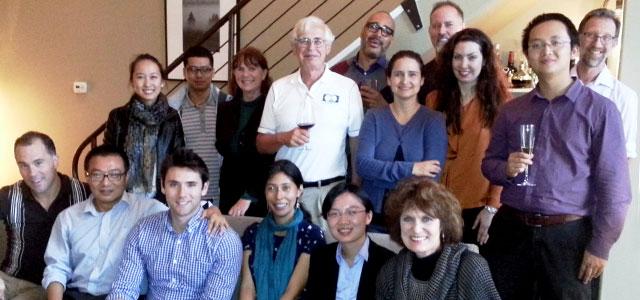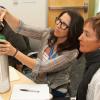
David Mortara (center, white shirt) and Barbara Drew (bottom row, far right) with members of the Drew Lab.
Heart Monitoring Research Excellence Spurs a Distinguished Professorship
In September 2013, the UC San Francisco School of Nursing announced its new David Mortara Distinguished Professorship in Physiological Nursing Research, a position generously funded by a research leader in electrocardiography (ECG). This is the School’s first distinguished professorship, the most prestigious gift possible in support of a faculty’s academic or research programs.
“Nurses and nurse researchers are becoming one of the driving forces in electrocardiography,” says David Mortara, an expert in designing and improving heart monitoring technology, an honorary fellow of the American College of Cardiology, founder of Mortara Instrument and an associate adjunct professor at the School.
Mortara says his primary motivation is to support the research of Barbara Drew, a professor of physiological nursing and founder of the School’s ECG Monitoring Research Lab (Drew Lab). The Drew Lab has built an international reputation for rigorous work focused on direct patient benefit.
“My decision to fund the professorship is based on respect for Barbara Drew’s contributions and the students and climate created within the Drew Lab, which I feel will be the basis of future successes,” Mortara says.
“It’s a wonderful acknowledgement that the work my research lab has been doing is important,” Drew says. “Dr. Mortara and I share the same vision that there is much more valuable information we can glean from the ECG, especially with continuous monitoring. My research has focused on improving the way we monitor patients’ ECGs in hospital, prehospital and home settings.”
“We are truly grateful that Dr. Mortara chose to recognize the diverse, interdisciplinary team that Dr. Drew has put together – a team that has enormous potential to solve some of the most pressing clinical challenges associated with advances in cardiac monitoring,” says Dean David Vlahov.
Advancing the Science
Mortara, who among other discoveries developed today’s widely used simultaneous 12-lead or 12-electrical-signal ECG interpretation, says advancing the field is increasingly about computer methodology rather than changes to equipment.
“Electrocardiography is more than 100 years old, and probably most of the benefits to be obtained by visual inspection of the ECG have already been discovered,” he says. “But more complex nuances, especially those related to changes in the ECG over the course of time, are more difficult to visually recognize, and these computer-developed measures…need to be brought to maturity.”
He believes that applying novel ECG methods to gain insight into breathing patterns and tackling the increasingly recognized problem of alarm fatigue are other pressing areas of research. Alarm fatigue can occur when nurses and other hospital clinicians are exposed to high numbers of alarms from patient-monitoring equipment – many of them false – which can make it difficult to prioritize responses.
“In the long term, I hope to see the School of Nursing continue to be recognized as a place of ECG research, with nurses empowered in patient care decisionmaking,” Mortara says.



